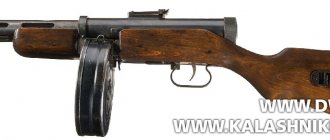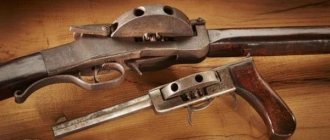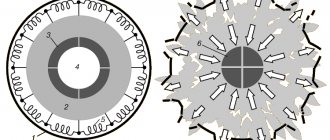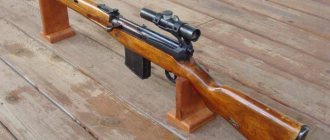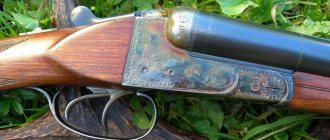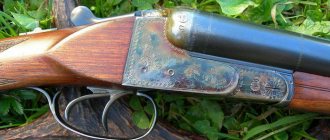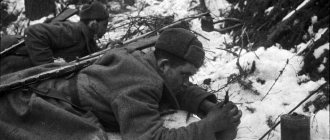The Finnish NKVD knife is one of the legendary weapons; today it is extremely rare, since most copies were destroyed in the 90s. Today, the remaining models can be found at exhibitions or auctions. The knife is very popular among connoisseurs of edged weapons, primarily because of its history. Today, such a knife is very rare, since in the USSR everything that was connected with the NKVD was subject to destruction, and the bladed weapons that they used were no exception.
Chronicle of creation
The national hunting knife of Finland “Puukko” was used as an image for production. Gradually, the Russian version acquired specific design features.
The history of the creation of the knife began in the mid-30s of the twentieth century, when Soviet craftsmen developed an original model for arming the special forces of the NKVD. An example for creating drawings was a miniature hunting knife by the Swede Pontus Holmberg. Beginning in 1935, knives of this type began to be mass-produced at.
Knives arr. 1935 weapons were never referred to as NKVD weapons in documents; they were called “Swedish-type knife.”
Serial production of bladed weapons was established at, which is located in the village of Vacha, Nizhny Novgorod region. The main difference from the Swedish version was the change in the guard, as well as the use of plastic instead of bone for the handle .
In 1940, the Finnish knife was adopted by intelligence officers, but it had too many design differences from what was used by the NKVD. The weapon was part of the material allowance of NKVD employees, while this model was never officially in service with the Soviet army.
Mark on history
The Finnish knife has not ceased to exist, both in Finland and in Russia. Many of its modifications are available for purchase in both countries. The widespread mention of this type of knife in the literature of the twentieth century guaranteed its reputation as a dangerous weapon for a long time.
In Bulgakov’s novel “The Master and Margarita” the mention of him sounds as follows: “This is how lightning strikes, this is how a Finnish knife strikes!”
It is worth noting that the original name, puukko, did not catch on in Russia, but the name “finka” gained such popularity that it allowed the knife to become more famous than in its homeland.
Design solutions and technical characteristics
The original Finnish NKVD knife had a number of characteristic parameters that distinguished it from many other models. The NKVD knife had specific tactical and technical characteristics:
- total length of the knife - 220-247 mm ;
- the blade was made quite narrow , its length was only 106-125 mm, and its width did not exceed 20 mm;
- The strength of the blade is ensured by the thickness of the butt - 4 mm and longitudinal side lobes.
- in front of the double-sided S-shaped guard to support the index finger for specific types of grip;
- the blade has a one-sided sharpening;
- the steel had a strength of 58 on the Rockwell scale ;
- the handle was made of carbolite with wood or bone inlays;
- Black or brown leather was usually used to make sheaths.
The sheath was fixed to the belt using a fastening loop and a button.
Knife Era
Today, the Finnish knife is sometimes called the Russian Finnish knife. But what was he like before the prefix “Russian”? The Grand Duchy of Finland was part of the Russian Empire in 1809-1917. Both Russia and Sweden gradually tried to disarm the indigenous population of Finland - without weapons it is difficult to fight for independence.
Tactics that have been proven, if not for millennia, then for centuries. But the Finns as a people at the same time have a rich experience of stabbings. Puukkoyunkari have been operating in the country for too long.
Puukkoyunkari - Finnish stabbing bandits
Image: work by Santeri Alkio Puukkojunkkarit
As Denis Cherevichnik writes in his book “The World History of Stabbings,” two hundred years ago in one of the districts of the country - Southern Ostrobothnia - the number of murders suddenly began to increase at a dizzying speed. This era became famous in Finnish history as Puukkojunkkarikausi (pronounced puukkoyunkari) - the era of knifemen.
The era of knifemen lasted more than a hundred years, from the end of the 18th to the end of the 19th centuries. During this time, more than two thousand residents of Ostrobothnia died from the knives of their fellow countrymen. This is a lot, considering that at that historical period the population of the region was only eighty thousand people
Denis Cherevichnik, “World History of Knifes”
Some researchers compare this period with the American Wild West era. The calling card of a hooligan, a stabber, and perhaps part-time a freedom fighter, was also a Finnish knife. Of course, it’s unlikely that anyone other than our compatriots calls them Finns; the Finns themselves certainly don’t. Their knives are called “puukko”, since “puu” in Finnish means “forest”, “tree”.
Equipment
The original security officer knife came with the following kit:
- The NKVD weapon itself with a red star had several modifications. For example, today there are several models of the original gun, which differ in the type of material and color of the handle;
- sheath. They were made only from dark-colored leather with a high level of hardness. Modern modifications may have a light-colored sheath. They are easily attached to your belt using a button.
Making a Finnish knife with your own hands
To make an NKVD finka of the 1935 model, you need to have a steel plate. Any brand will do, but 95X18 is recommended. It will produce a product of decent quality and characteristics. The following materials and tools will be required:
- angle grinder - grinder;
- electric drill, marker;
- hacksaw for metal;
- welding machine;
- special sharpening machine;
- drill, needle files;
- vice and sandpaper;
- files of different grains.
The manufacturing process will look like this:
- A drawing is made on cardboard or paper of the future product. Then a template with a shank is cut out.
- Next, it is applied to the steel plate and outlined with a marker along the entire perimeter. When using an angle grinder with a cutting wheel, you should cut the workpiece along the drawn lines.
- Using a grinding machine, the part is smoothed. If it is not there, then files will help.
- Next, you can begin making bevels on the blade. It is necessary to mark the places of the valleys.
- The next step will be hardening the workpiece in a forge furnace. Cooled in oil. Remember to release the steel.
- The product is polished with finer grains. Here you can use sandpaper.
- The final step will be polishing the blade using a felt wheel and GOI paste.
- The finished guard and butt are processed on a milling machine so that they fit in size.
- The polished surface should be sealed with masking tape for further work.
- A thread is cut on the shank for a nut or a stud can be welded.
- A birch block is prepared for the handle. It is necessary to make a hole in it in accordance with the thickness of the shank.
- Epoxy resin is diluted, the junction with the guard is coated, and liquid is poured into the hole in the handle blank.
- The shank is inserted; its end should be slightly longer than the handle.
- A nut is screwed onto the thread of the shank for fastening.
- It is covered with a brass pommel and glued to resin.
- The machine processes wood to the required shape.
- The handle is then ground and the pommel is polished.
- The wood is treated with a special impregnation.
Step-by-step making of a Finnish knife.
How to use a finka
The design of the Finnish knife was carefully worked out; at one time, this weapon was considered a successful development, perfectly coping with the assigned tasks.
The knife was especially appreciated for its compact size, which was extremely convenient for transportation.
At the same time, the strength and reliability of the structure were often overestimated. Despite this, in the 30s of the twentieth century, many legends spread that overestimated the capabilities of the NKVD Finns.
Nowadays, the Finnish knife can be used for the following purposes:
- Souvenir. Military model knives are often used as souvenirs when there is an engraving on the handle or blade. An original knife or even a high-quality replica will evoke sincere positive emotions in any collector or fan of bladed weapons.
- Tourist knife. Considering all the technical characteristics of the Finnish knife, one can note a strong similarity with modern tourist knives. Considering the compactness of the gun and ease of transportation, it can be used with great success as a weapon when going outdoors.
- Self-defense. At the same time, it is worth having basic skills in using edged weapons. In addition, in order to store and wear a high-quality replica, or even more so an original NKVD finca, you must have a permit established by the state.
Weapons of the marginalized
If we talk about the Russian part of the Finnish history, then many criminals, robbers and hooligans in the north-west of Russia began to use classic Finnish knives even before the revolution. Often unchanged - a simple handle, the blade is much narrower
and also simple, with a slight bevel at the tip.
Some historians attribute this to the fact that since the 80s of the 19th century, the tsarist government began to Russify part of the Finnish territories in an attempt, among other things, to weaken the Finnish national movement. In a short period of time, “cultural exchange” led to the fact that the Finnish weapon became the most popular weapon of the marginalized people of St. Petersburg.
Then this fashion reached Moscow and other regions. And after the revolution, the level of crime jumped sharply - and something had to be done about it. In 1917, the Council of People's Commissars (SNK) came to power, which a year later issued a decree “On the surrender of weapons.”
Oblige the entire population and all institutions of the civil department to hand over the serviceable and faulty rifles, machine guns and revolvers of all systems, cartridges for them and sabers of all types. All weapons storage permits issued so far are considered invalid.
from Decree of the Council of People's Commissars No. 993 of December 10, 1918
Historians and researchers often agree that the Finnish woman, which by this time was already popular, after the decree of the Council of People's Commissars became an attribute of disobedience. Hooligans, punks, outcasts and other criminals began to walk around with “household” Finnish knives, which by definition did not fall into the category of weapons.
It so happened that an object that in the vast majority of cases was used as a weapon was difficult to recognize as a weapon. Moreover, life changed not only in big cities; news of stabbings in rural areas became more and more frequent.
Handicraft finca made in prisons
Photo: allzip.org
Gradually, the custom of fist fights began to resemble hooliganism more and more in form and was accompanied by stabbings. There were growing reports that aggressive youth, huddled in groups of about ten people, kept the small village in fear, feeling their impunity and growing fearlessness before the law. These events were very reminiscent of the “stab era” in Finland.
Ninka, like a picture, rows with a friend. Give me, Kerya, a Finn, I’ll go forward!
Alexander Rosenbaum
Modern replicas
Today it is extremely difficult to buy a real NKVD Finnish car. Usually you can get such a model of bladed weapons at auctions abroad, and the cost per unit can exceed tens of thousands of dollars.
So, if you want to personally touch a piece of history, but cannot take part in the auction, you can take a closer look at the replicas, of which there are many today. There are craftsmen who make copies of such high quality that only a true professional can distinguish it from the original.
Modern replicas are produced by different manufacturers; they can differ significantly in appearance, quality and price.
Often replicas have some design changes. This is done in order to make a model that will not fall under the classification of edged weapons and put it up for free sale.
The first duplicates of the legendary Finnish NKVD knife began to be produced by the leading armory in Zlatoust. It was here that the model saw its first replica called “Finka-1”, which was produced in several modifications. If we take into account modern collectors, they prefer more modern models called “Finka-2” and “Finka-3”.
They claim that it is the second and third modifications that most accurately reproduce the original model, the very same NKVD Finnish machine made in Vacha. But despite the close similarity, the models have several differences:
- a variety of materials are used for the handle, which affects the cost;
- The thickness of the butt is 2.3 mm.
Moreover, these factory models fully imitate the original; the cost per unit ranges from 130 to 160 euros, which is at least 20 times cheaper than the original.
In addition to factory models, there are also high-quality copies that were given life by private craftsmen. The quality of such products is usually not compromised by the original ones. At the same time, the cost of such models can reach the cost of the original NKVD Finnish weapon; even experienced experts in edged weapons cannot distinguish them from such masters.
Also today there is a fairly popular folding interpretation of the NKVD Finnish. There is a characteristic red star on the handle. To throw out the blade of such a model, you need to turn part of the guard, which in itself looks quite impressive and improves the impression. Such models have the following characteristics:
- blade length – 106 mm;
- blade width - 17.5 mm;
- handle length - 135 mm;
- butt thickness - 3 mm.
Varieties
Classic Finnish blades are usually divided into two groups: puukko and leuku. Puukko is intended for hunters. The knife is considered the prototype of the Finnish knife; it is equally famous in Norway and Sweden. This characterizes the blade as indispensable for housework in northern climatic conditions. The Finnish puukko knife is divided into groups according to function:
- a knife with a soft bend in the spine - for manipulating wood;
- hunting;
- with a wide blade;
- short blade - for wood.
The blades are often not long, up to 100 mm. They often have gutters on the sides and slopes from the center of the butt, reduced to zero. Four generations of craftsmen living in specific areas of Finland make these high-quality blades.
Puukko have a difference in the through installation of the blade, and the front end of the handle is often reinforced with a metal bolster.
Leuku is the Finnish name for the knives of the Sami people inhabiting Lapland. They differ from puukko in their greater thickness, weight and length. They can replace small hatchets; they can easily trim stakes and split splinters. Leuku blades are similar to Chukchi and Koryak blades:
- the blade is long, large and wide;
- butt, widens towards the handle, large;
- handle at the end in the form of a mushroom - for firmly holding the blade in the hand when making a strike;
- A distinctive feature of Lapland knives is the tip on the sheath made of deer antler, for easy holding when removing from the sheath.
Leuku
Puukko
Owner reviews
Mikhail, Samara: “I ordered the NKVD Finnish car via the Internet, I received it the other day, the quality is super! The blade, the handle, the guard - everything was fine. It fits in the hand like a glove. The steel is good. I will test it further."
Anton, Kolomna: “But I was unlucky with my order; I purchased it from a well-known manufacturer. Everything is beautifully decorated. But steel does not meet its parameters. The blade is dull and doesn't cut anything. The handle is made of Karelian birch and is not impregnated. Just bare wood. I had to do the impregnation myself. Disappointed."
Valery, Ryazan: “For my birthday, my friends gave me a Finnish knife. I've been dreaming about this for a long time, beautiful, sharp, comfortable. Of course, I’m not going to walk down the street with it, I’ll hang it on the wall and show it to guests.”
Popular manufacturers
The oldest Finnish company, Iisaki Järvenpää, was founded in 1879. Master Iisaki Jarvenpaa made his first knife at the age of 20. He even managed to make a blade for Nikolai Alexandrovich, the heir to the Russian throne.
By this act he received the title of supplier to the court of His Imperial Majesty. In addition to making traditional knives, Iisaki Järvenpaa also made exclusive products. On the top was the head of a horse or dog.
Pukko and leuku knives are produced by the well-known company Ahti. The blades are made of the highest quality. The owner and his son make knives by hand. During the process, all traditional production features must be adhered to.
Finnish fisherman Aarno Korpikannel founded his own blade manufacturing company in 1957. He had an original approach to the manufacture of products; the scabbard was covered with elk skin.
Such a product will be useful not only in everyday life, but also as an unusual gift.
The Marttiini company was founded in 1928. It was organized by master blacksmith Janne Marttiini. Traditional knives are made there, including hunting, fishing and kitchen knives. The company was gaining popularity, and after moving the city, deliveries began to different countries.
The history of the Roselli company began without even having a normal tool for making knives. Heimo Roselli made knives for his neighbors and friends. But I quickly realized that I needed to get things moving. That's how this company came about.
The end and... the beginning?
The Khrushchev thaw finally finished off the Russian Finn, which was marked by the fact that through the holes in the “Iron Curtain” those interested discovered the true diversity of the world of the knife. It turned out that the Finnish knife is not a weapon of the marginalized, but an ordinary national knife. The masses were carried away by new trends - European and American models quickly replaced the once popular Russian Finnish style. The end of the artel movement and the “nationalization” of this last island of entrepreneurship led to the final crisis of the domestic knife industry, from which it barely began to climb out only towards the end of the 20th century. Even the forensic authorities were forced to “rehabilitate” the puukko - already in the methodological manual “Edged Weapons and Household Knives”, published by the All-Russian Research Institute of the Ministry of Internal Affairs of the USSR under the editorship of A.I. Ustinov in 1978, the Finnish knife appeared in the section “Hunting knives, daggers and dirks”. Paying tribute to the high significance of this work for Russian criminology and weapons science, it should be noted that the authors did not have enough civil courage to call a spade a spade and admit that the Finnish puukko knife is just one of the varieties of national knives, and people convicted of “Finnish knife” in the USSR, they were, as a rule, imprisoned for handicraft domestic knives of any type.
The production of relatively high-quality handicraft knives, meanwhile, moved to production due to the decrease in strict control over it and the weakening of production discipline at enterprises of the national economy. The administration, as a rule, turned a blind eye to this “creativity” - they say, if you get caught, it’s your own fault. Some of the cutlers working for “the powers that be” generally felt relatively safe, because the authorities loved expensive and beautiful toys and the command from above was given not to touch them. Under these conditions, the popularity of the Finnka as a Russian handicraft knife of original design began to decline rapidly and by the mid-80s it had almost disappeared, replaced by new models from available Western catalogs and bloody Hollywood action films.
Thus, V. Artemenko, who is close to the structures of the Ministry of Internal Affairs, admitted in the article “Choosing a knife” (Magazine “Ruzhye” No. 8 / 1996):
“My eleven-year observations of the assortment of seizures led to the disappointing conclusion that post-Soviet society has lost the criterion for choosing a knife. Even before the invasion of numerous Far Eastern and “from under the palm trees” crafts into the CIS market, Western tastes in their ugliest manifestations (from the pages of cheap catalogues) penetrated into places of detention and finished off the domestic tradition. ...Russian knives in Russia are becoming a criminal rarity.”
Is it possible for it to return as a combat knife? Unlikely. Even the M-95 Sissipuukko army knife (from the Finnish sissit - scout, ranger, partisan), developed by Captain Peltonen and manufactured by Fiskars, was never adopted into service in Finland. Nevertheless, it enjoys some popularity among the troops as a means of personal equipment purchased at their own expense, and is much closer to the American knife tradition: a sheath with a side seam, a rubber handle with a limiter, a fairly long blade - 160 mm with a total length of the knife of 290 mm. And this is not surprising - initially this blade design was proposed as a prototype bayonet for the Finnish Valmet M62 assault rifle, and the first prototypes of the M95 were generally a bayonet mount without devices for attaching to the M62.
With regard to turning it back into a criminal knife, the answer is not so clear: experts have noted a recent trend towards some tightening of the ECC requirements for utility knives. Still, let’s hope that Russian criminologists will not follow the path of their British colleagues, who, after the widespread ban in England of non-folding and folding knives with a lock, have already taken up linoleum Stanleys with replaceable break-off blades.
